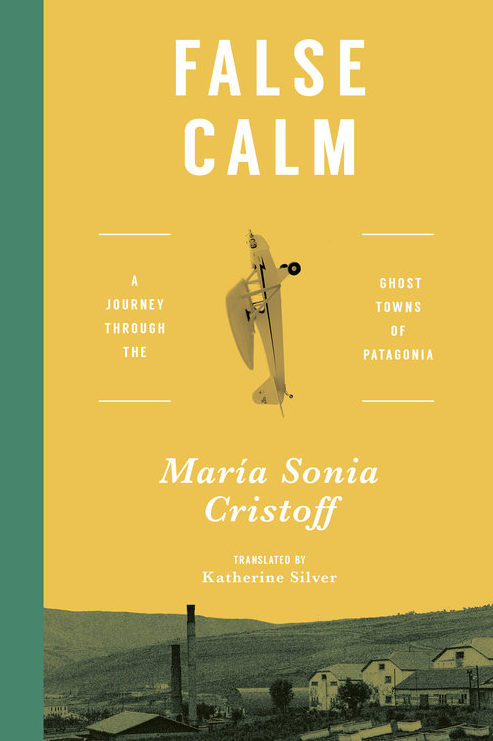False Calm
by María Sonia Cristoff, translated by Katherine Silver
reviewed by Kyle Paoletta
Few places have been romanticized as thoroughly as Patagonia. Throughout the twentieth century, the dramatic topography of Southern Argentina drew in writers like Bruce Chatwin and Antoine de Saint-Exupéry, and their books helped to make the name of the region so synonymous with adventure that it is now the moniker of one of the largest outdoor-apparel brands in the world. In False Calm, native daughter María Sonia Cristoff returns to Patagonia after nearly two decades in Buenos Aires to report on the people scraping together a living in its oil fields and depopulated communities. Far from destination climbing and picturesque vistas, the Patagonia she describes is a landscape “disrupted by a kind of nightmarish logic, where I could walk and walk but still remain in the same place.”
The stories Cristoff uncovers among Patagonia’s residents are startling and surreal. A former roughneck named Francisco tells her about the mental block he developed while learning to fly a single-engine aircraft he found abandoned in a shed. Though a capable pilot, he was unable to land the machine, proving that “he was made to look at airplanes, not fly them.” Federico, who maintains oil wells, tells her of the loneliness of his occupation. “To go into the fields is to go into another dimension,” he says. “After a while, you’re overtaken by a kind of daze, a stupor.” Cristoff’s tightly rendered profiles have a similar feel to the vignettes Joan Didion became famous for in her early reporting, and offer a similar depth of understanding about the setting under scrutiny. Just as Didion used the collaging of her subjects in The White Album to depict the countervailing forces of ambition and danger in California, Cristoff adeptly reveals Patagonia as a land beset by a deep sense of alienation.
As “the locals’ eagerness to tell their stories, so abundant at the beginning, starts to wane,” Cristoff’s willingness to linger in each town she profiles diminishes as well. In El Caín, the lone village in a vast natural preserve, Cristoff spends her days walking out into the countryside, wondering when the moment will “arrive that is deemed desirable, when one enters a different state.” In Maquinchao, her insomnia drives her to read a Hannibal Lecter novel until dawn. When she finally falls asleep, Chatwin himself appears to her in a dream, “talking nonstop, in a monotone but with urgency, about how Shakespeare was inspired by a Patagonian Indian to create Caliban in The Tempest.”
These glimpses of how the landscape affects Cristoff bolster the credibility of her portrayal of the people who inhabit this place—if it’s this bad after a few weeks, she implies, imagine spending decades here. Nowhere, however, has suffered quite like Las Heras. The small city is facing a rash of suicides, a great portion of them children. A woman named Martina tells Cristoff of how she attempted to poison herself three times before she turned twelve, hounded by a despair she likens to “a sharp whistling sound that saps you from the inside.”
Las Heras, Cristoff believes, is a place hypnotized by “a combination of the apparent monotony of the landscape, the constant wind, and the brutal presence of the sky.” If people do not die by suicide, “they find other ways of cancelling themselves out [ … ] They consume substances that stupefy them for life, and they get pregnant in order to be diluted with another.” Patagonia, in this depiction, feels of a piece with Appalachia in the American imagination, a rural area ravaged by generations of neglect. But while J.D. Vance sought to resuscitate the image of Appalachia in his memoir Hillbilly Elegy, Cristoff has little interest in extending the same generosity to Patagonia. At the book’s 2005 release in Argentina, its mostly Argentinian readers likely assumed Cristoff’s purpose to be exposing the suffering down south they were only dimly aware of, rather than cheerleading the region’s recovery. Now that the book is being read in Katherine Silver’s translation in North America, Cristoff’s reportage has a new role, forcing readers abroad to come to terms with the hard reality of life in a place they’ve only ever associated with glossy advertising campaigns.
Cristoff’s last subject is Sandra, a paranoiac convinced that her neighbors are psychically manipulating Las Heras’ residents into suicide. Her evidence for this is a “stack of papers,” revealed to be the exact same news article, “photocopied to death.” Sandra’s mania, like Federico’s narcotized daze, are offered as examples of how one survives in Patagonia. There are no enlivening retellings of man against nature in Cristoff’s book, nor painterly evocations of the horizon. There are only people grasping at survival. Cristoff’s unwillingness to offer the reader even a sliver of hope about the place is hard to bear. But again, Cristoff is challenging us. Just imagine spending your life here, in this “netherworld.”
Published on June 5, 2019

